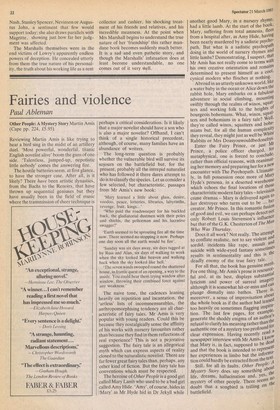Fairies and violence
Paul Ableman
Other People: A Mystery Story Martin Amis (Cape pp. 224, £5.95) Reviewing Martin Amis is like trying to hear a bird sing in the midst of an artillery duel. 'Most powerful, wonderful, titanic English novelist alive' boom the guns of one side. `Talentless, jumped-up, nepotistic little nobody' comes the answering fire.
The hostile batteries seem, at first glance, to have the stronger case. After all, is it likely? There have been artistic dynasties, from the Bachs to the Renoirs, that have thrown up sequential geniuses but they have usually been in the field of music where the transmission of sheer technique is perhaps a critical consideration. Is it likely that a major novelist should have a son who is also a major novelist? Offhand, I can't think of a single historical precedent, although, of course, many families have an abundance of writers.
The long-term question is probably whether the vulnerable bird will survive its sojourn on the battlefield but, for the present, probably all the intrepid naturalist who has followed it there dares attempt to do is to classify the s'pecies. Let us consider a few selected, but characteristic, passages from Mr Amis's new book: 'Mary learned a little about glass, desire, voodoo, peace, lotteries, libraries, labyrinths, revenge, fruit, kings,..' 'Who paid the roadsweeper for his buckled back, the gladiatorial dustmen with their poles and shields, the policeman and his lucrative swagger?'
'Earth seemed to be sprouting fire all the time now. There seemed no stopping it now. Perhaps one day soon all the earth would be fire'.
'Sunday was six days away, six days tugged at by Russ and Alan, six days of walking to work when the sky looked like heaven and walking back when the sky looked like hell.' 'The seven winds swooped round the shuttered house, in frantic quest of an opening, a way to the inside. You could hear them trying window after window, throwing their combined force against any weakness.'
The naive tone, the cadences leaning heavily on repetition and incantation, the 'artless' lists of incommensurables, the anthropomorphising tendency are all characteristic of fairy tales. Mr Amis is very popular with young readers. Could this be because they nostalgically sense the affinity of his works with nursery favourites rather than because they find in them reflections of real experience? This is not a pejorative suggestion. The fairy tale is an allegorical myth which can express aspects of reality closed to the naturalistic novelist. There are far fewer great fairy tales than, perhaps, any other kind of fiction. But the fairy tale has conventions which must be respected.
The heroine of Other People is a good girl called Mary Lamb who used to be a bad girl called Amy Hide. 'Amy', of course, hides in 'Mary' as Mr Hyde hid in Dr Jekyll while another good Mary, in a nursery rhyme, had a little lamb. At the start of the book, Mary, suffering from total amnesia, flees from a hospital after, as Amy Hide, having been nearly murdered by a sadistic psychopath. But what is a sadistic psychopath doing in the world of nursery rhymes and little lambs? Demonstrating, I suspect, that Mr Amis has not really come to terms with his own creative orientation and remains determined to present himself as a cool, cynical modern who flinches at nothing. Abroad in an utterly unknown world, like a water baby in the ocean or Alice down the rabbit hole, Mary embarks on a fabulous adventure in social climbing, mounting swiftly through the realms of winos, squatters and working folk to the heights of bourgeois bohemians. What, winos, squatters and bohemians in a fairy tale? Well. they're called winos, squatters and bohe' mians but, for all the human complexitY. they reveal, they might just as well be -White Rabbits or Mrs Doasyouwouldbedonebys. Enter the Fairy Prince, or just 10. Prince, a police officer charged, f°I metaphysical, one is forced to conclude, rather than official reasons, with reanimate ing her memory and preparing her for a new encounter with The Psychopath. Ultimately, in full possession once more of Mary Hyde's persona, in a deserted warehouse which echoes the final locations of those characteristic modern fairy tales — televisi°° crime dramas — Mary is delivered again to her destroyer who turns out to be ..• her creator, Mr Prince. In this romantic fusion of good and evil, we can perhaps detect not only Robert Louis Stevenson's influence but that of the G. K. Chesterton of The Marl Who Was Thursday. Does it all work? Not really. The atteMPI, to conflate realistic, not to say violent an°, sordid, incidents like rape, assault all suicide with wide-eyed fantasy sometimes results in sentimentality and this is the deadly enemy of the true fairy tale. , For all that, the book has genuine malt' For one thing, Mr Amis's prose is resource; ful and, at its best, displays substantial lyricism and power of surreal imagerY although it is somewhat hit-or-miss and earl plunge dismally into bathos. There moreover, a sense of improvisation abotu, the whole book as if the author had leane° too heavily on sometimes flagging inspiretion. The last few pages, for examPle,generate the shoddy enigma of an author 5 refusal to clarify his meaning rather thanthe authentic one of a mystery too profound for clear expression. Having recently read a newspaper interview with Mr Amis, I knavid that Mary is, in fact, supposed to be dea and that the book is intended to represem her experiences in limbo but the inforrna" tion could hardly be extracted from the teII`A Still, for all its faults, Other People: Mystery Story does say something ab°,11,, life, dreams, hallucination and, yes, tuo''' mystery of other people. There seems IL doubt that a songbird is trilling Oft battlefield.






































 Previous page
Previous page